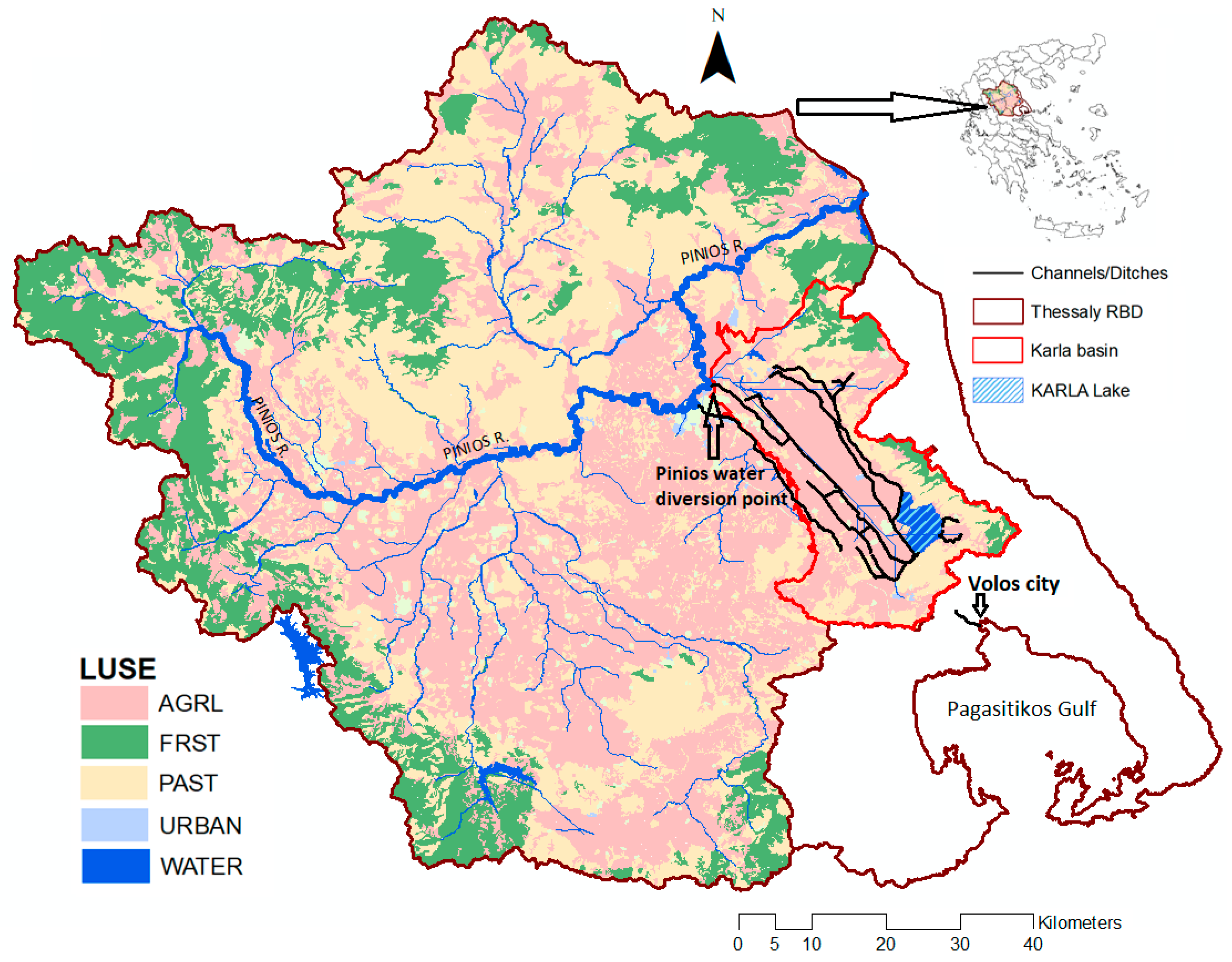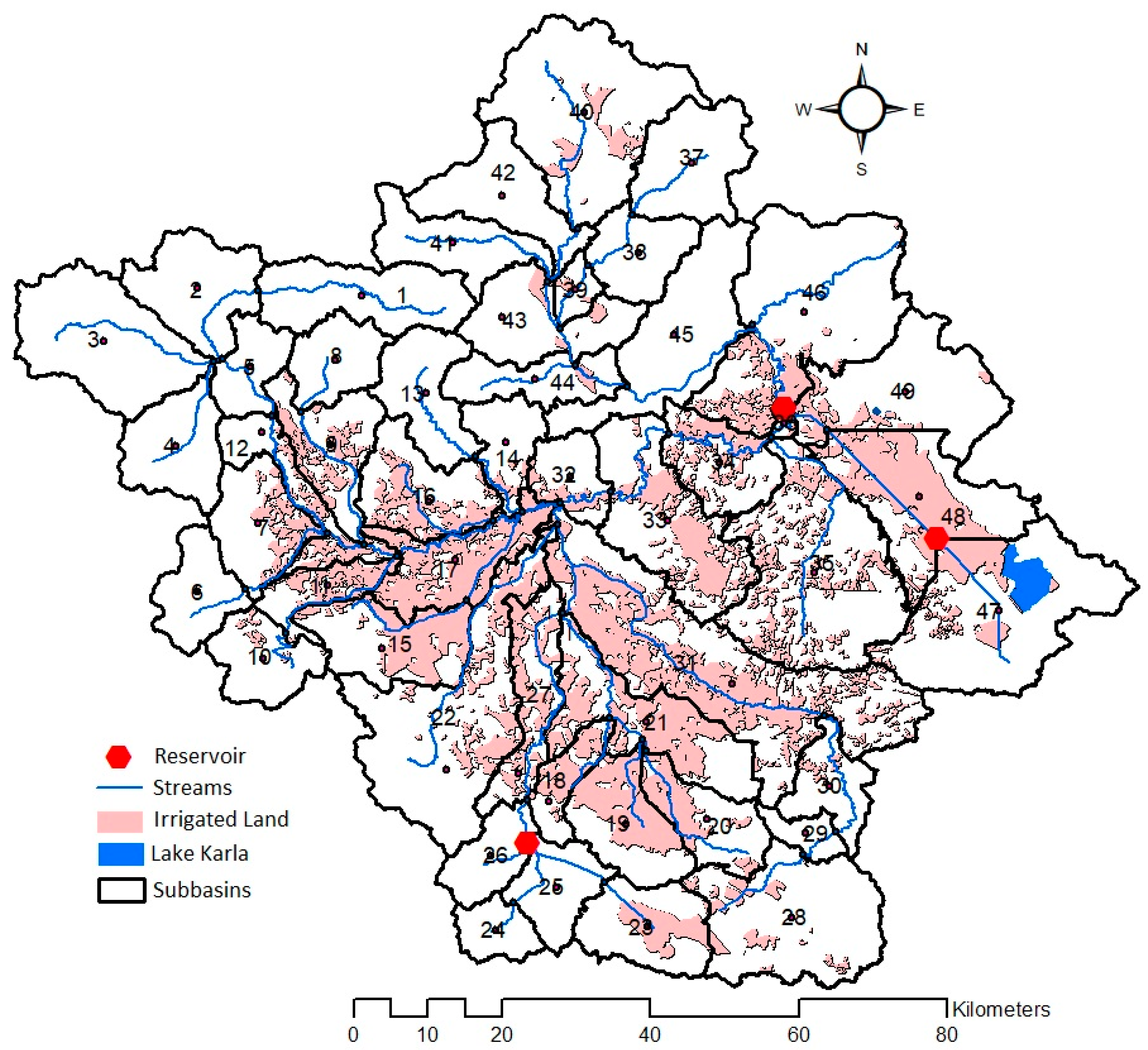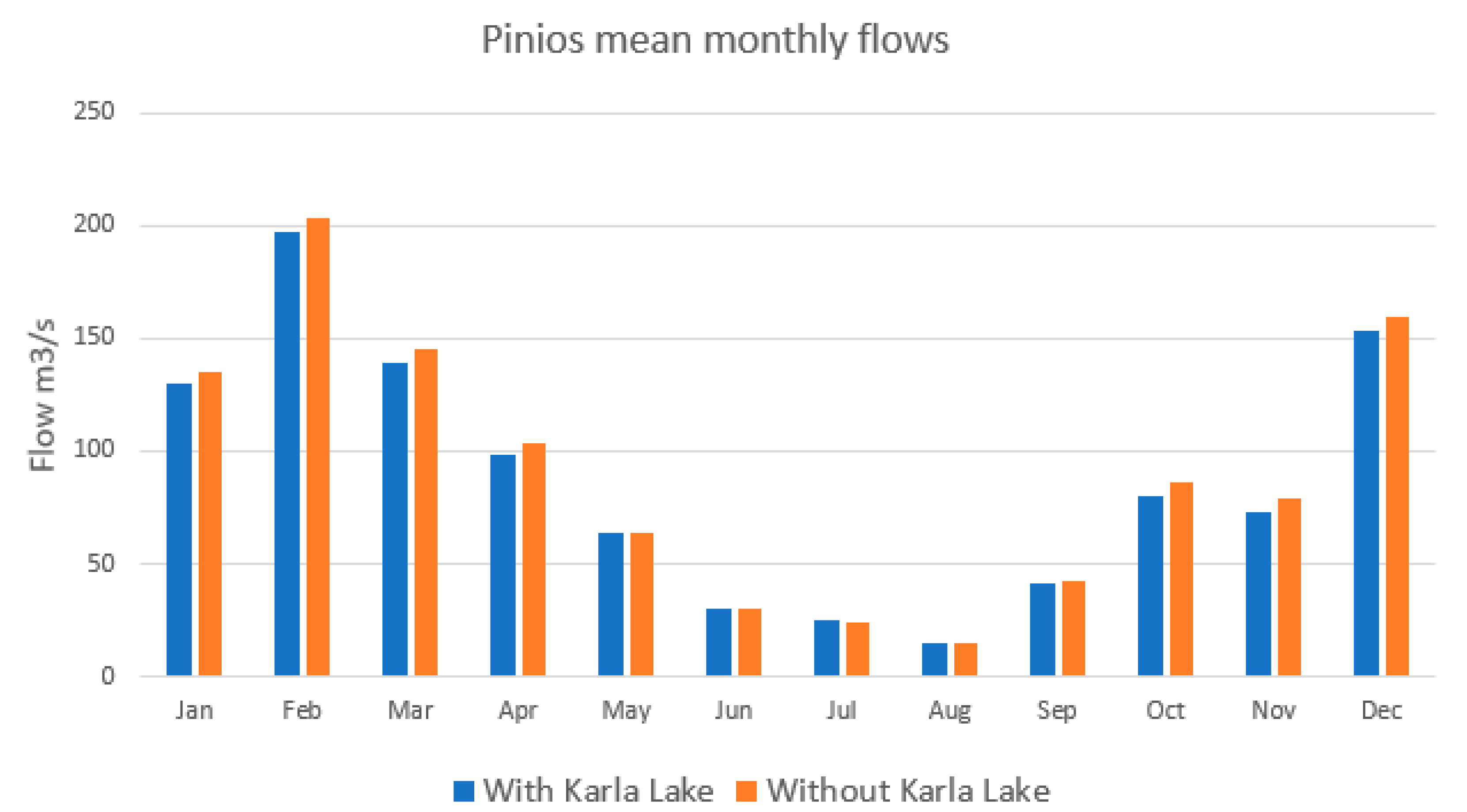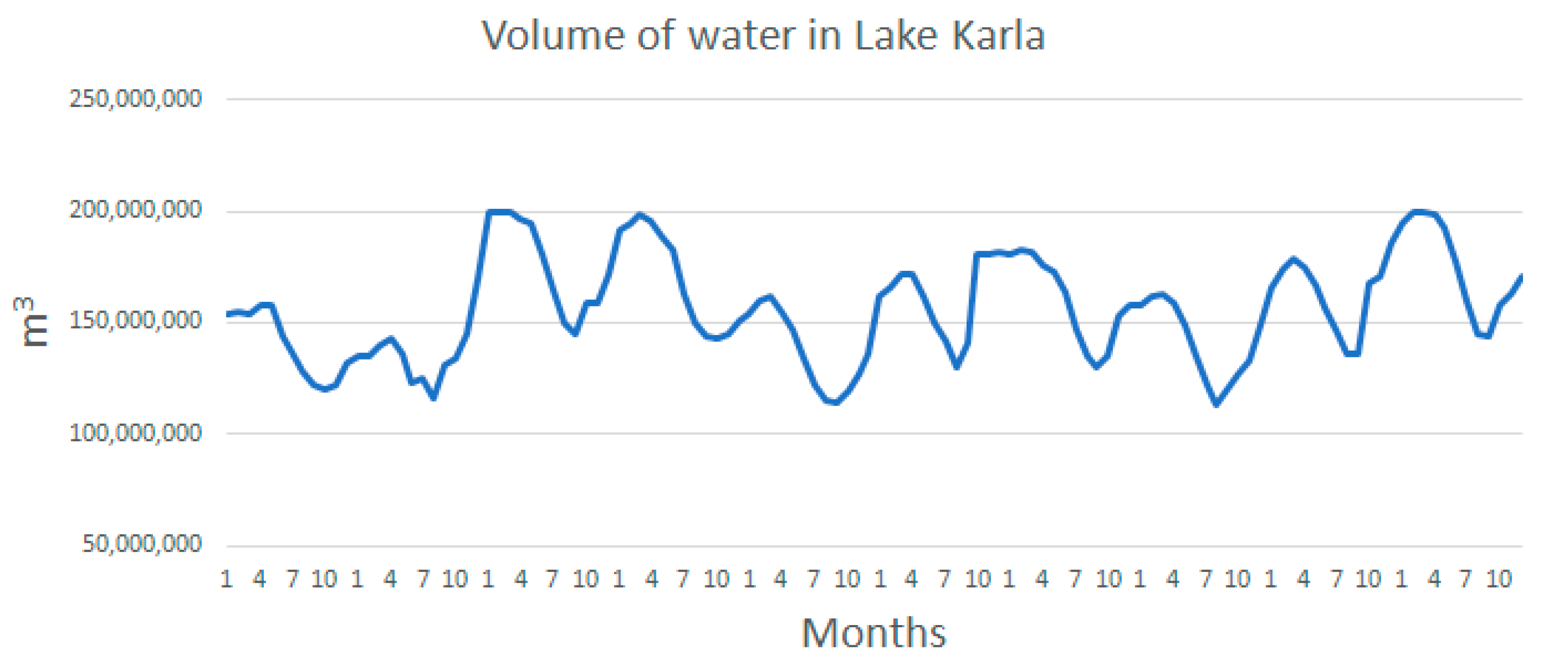3.1. Modelling Outputs
The SWAT model produced monthly and annual results for a 10-y period for both scenarios: (A) With the Lake Karla in place (baseline scenario) and (B) without the lake in the most southeastern part of the Pinios basin. Among the results of interest are the monthly/annual flows of the Pinios River, the irrigation amounts applied to the agricultural areas along with the crop yields, as well as the water budget of Lake Karla in Scenario A in the study area. Model outputs of most interest are summarized in
Table 4.
In the business-as-usual scenario with a full operating Lake Karla, the model simulates a mean annual flow of Pinios equal to 86.76 m
3/s, almost 3.5 m
3/s less than the simulated flow without the water transfers from Pinios to Lake Karla. Empirically, this flow reduction figure is rather low (less than 5% of the average annual reference flow) and, given the fact that the particular amount of water is abstracted during winter, the relevant hydrological impacts are not important.
Figure 4 shows the mean monthly Pinios flows within the 10-y simulation period where the very small differences for the wet months are indicated. Those differences of the baseline Scenario A (with Lake Karla) from Scenario B (without Karla and water diversions from Pinios) are small, thus, their small magnitude does not have the capacity to attenuate possible floods along the downstream part of Pinios River. On the other hand, the river flows in summer remain unaltered between the two scenarios, as water transfers from Pinios to the lake take place only within the high-water availability period. The present result is a good indication that without any impact on Pinios River low flows during the dry period of the year, but also without important consequences on the high flows, a significant amount of water can be abstracted from Pinios during the high-flow winter period to give life to an ecosystem quite far, within Pinios basin, where the necessity for more water is high, especially during the dry period, to combat water scarcity and desertification.
A more important result of the present modelling is related to the amount of irrigated water abstracted and applied in the cotton fields of subbasin 47 (see
Figure 3) along with the cotton yield simulated. In Scenario B, the model was forced to apply 500 mm (5000 m
3/ha) of water through 10 doses of 50 mm from May to September by abstracting water from groundwater. The availability of water, however, did not allow the doses to be covered entirely. Thus, only 215 mm (2150 m
3/ha), less than 50% of the optimum, was finally abstracted and applied on a mean annual basis. On the other hand, with Lake Karla in the model (Scenario A), water was always available to apply to cotton fields and the optimum irrigation amounts of the 10 doses were completely satisfied. This resulted to an almost double mean annual cotton yield simulated as 4.89 t/ha for the 8000 of cotton land in subbasin 47 (
Figure 3), which is reasonable after communications with local farmers who have deeply realized the response of cotton yield to the actual irrigation water amounts applied. The 2.2 t/ha difference compared to the no-Karla scenario, resulted from the crop-growth routine of SWAT which takes, among others, water stress days into consideration to accumulate crop biomass development on a daily basis [
31]. As fertilization and climate did not differ between scenarios, changes in crop yields are solely attributed to irrigation water applied.
Another important model output is the water budget of Lake Karla within the simulation period, presented on a mean annual basis in
Table 5. As already explained, a minimum water level of 2.5 m and 100 hm
3 in the lake should always be maintained to support biodiversity. SWAT simulated monthly water storage as shown in
Figure 5 for the 10-y simulation period. The graph reveals that our modelling respects the threshold of 2.5 m in the lake throughout the simulation period. During all months of the simulation, even the summer months when abstractions are maximized, the volume of water does not drop below the limit of 100 hm
3. It is noted though, that in three months within the simulation period water volume reaches the maximum storage capacity of 200 hm
3 resulting in water overflowing outside the basin. This water is lost from the system representing the removal of overflowing water to the sea in reality.
3.2. Effectiveness of the Nature-Based Solution
There are various ways to calculate the effectiveness of a measure, practice, or even big project like the NBS of Lake Karla. The effectiveness can express how much water is saved from the NBS or to what extent water can be used for an objective’s achievement. Here, we present some metrics of effectiveness resulted from the outputs that fit best to the study.
With Lake Karla the irrigation requirements are fully covered or the effectiveness of the NBS in meeting agricultural water needs is maximized (100%). Without the lake, only 215 mm out of the optimum 500 mm of water are used per year. The effectiveness of covering irrigation needs is only 43%. Therefore, the Lake Karla scenario increases water exploitation by 100/43 = 2.32 times or 132%. Total cotton production with Karla is double than without it; the 8000 ha irrigated and the respective productions are 39,120 t and 21,520 t per year. Therefore, the effectiveness of the NBS in increasing productivity is almost 100%.
Water saving in natural water bodies is very important as well. Lake Karla resulted in zero groundwater pumping for serving 8000 ha of land, which would be irrigated annually with 17.2 hm
3 of groundwater otherwise (without Karla). This 17.2 hm
3 is available for total abstraction of groundwater from the aquifer of subbasin 47 (see
Figure 3), which, in SWAT, coincides with the area of the subbasin (area of subbasin 47 = ~480 km
2). Therefore, for a land area of 480 km
2 in subbasin 47 when Karla does not exist (Scenario B), SWAT simulates a net groundwater recharge rate of ~35 mm/y resulting in 17.2 hm
3/y, abstracted entirely for irrigation. Without the 38 km
2 Lake Karla in place the simulated net aquifer recharge from that fallow area of 38 km
2 would be almost 38 km
2 × 35 mm = 1.35 hm
3. In Scenario A with Karla, seepage from the lake’s bottom is simulated at a rate of 0.1 mm/h (see
Table 1), resulting to 33.2 hm
3/y of aquifer recharge from the 38 km
2 area, almost 30 hm
3/y more. In total, it can be estimated that, around the Karla plain, groundwater replenishment is extremely important as the aquifer gains tens of hm
3 per year. According to the estimations herein, gains approach 50 hm
3/y, which arise both from the substantially increased percolation of water and the zero groundwater abstractions.
A final metric of effectiveness is the extent to which the Lake Karla project can reduce Pinios high flows. In our model there is a stable abstraction of 5 m3/s (430,000 m3/d) from Pinios for diversion to Lake Karla from October to April. For the high winter monthly flows of the river (80 < Q < 200 m3/s) such a subtraction of water results to a less than 5% flow reduction. Therefore, with the present pumping stations along Pinios that divert water through the transport ditches to Karla, the effectiveness of the NBS to reduce high river flows and the potential flood risk along Pinios River can be considered low. Nevertheless, since the water routing capacity of the transport ditches is quite high, one could think of using the system also for flood mitigation in the Pinios River itself with the purpose to reduce the flood inundation risk for parts of the agricultural plain downstream. This would require more dedicated hydraulic works at the point of water withdrawal from the Pinios River towards Lake Karla.
3.3. Cost Recovery
According to the WFD, an economic analysis of water uses includes: (a) Estimation of the current financial, environmental, and resource cost of water; (b) calculation of the cost recovery; and (c) discussion of flexible pricing policies that offer incentives for efficient use of water resources and for the achievement of the environmental objectives of the Directive. The categories of costs to be considered are: (a) Financial cost, including operational and maintenance costs, capital costs, administrative costs; (b) resource costs, defined as opportunity costs for the alternative uses of water; (c) environmental cost, defined as economic cost due to the environmental damage caused. The financial cost is usually the largest type of cost, which can be directly estimated. On the other hand, the estimation of the resource and environmental costs is more difficult as one has to consider and quantify the foregone benefits and environmental damage caused, respectively. Studies relevant to the Pinios River basin, dealing with the estimation of the full cost of irrigation water, have shown that both the last two types of cost can be quite important, especially in water scarce areas with high irrigation needs such as Pinios basin [
38,
39].
However, within the context of constructing the Lake Karla NBS in this work, the resource cost can be considered negligible as natural runoff waters from Lake Karla’s surrounding areas and diversion water from Pinios to Karla would not be used otherwise. In fact, Pinios flows of the wet months of the year would be only slightly higher along the most downstream part of the river. The transfer of river water due to the diversion cannot be considered an adverse effect and cannot cause a remarkable resource cost, since river water was naturally overflowing towards the original Karla lake in the past when reference hydrologic conditions in the basin dominated. On the other hand, significant groundwater resources are saved and can theoretically be used for other purposes or in other adjacent areas. In this case, additional crop areas from those irrigated with water from Lake Karla could be served by the water saved in the aquifer resulting in crop yield increase and additional income. Although this benefit is important, saved groundwater is not exploited for other purposes in this study because of technical and economic issues (e.g., additional constructions are required to transfer water to longer distances) that require a detailed focused study to be performed. Therefore, it is beyond the scope of this study to suggest where saved groundwater can be used in the future and calculate the economic benefit from this action. Finally, there is negligible environmental cost from the construction of Lake Karla since it is a restoration project to re-establish part of the original lake that has significant environmental benefits while increasing the local aquifer’s water availability.
As calculated above, the annual cost recovery of the Lake Karla project should be around €15,000,000 per year for a 50-y lifetime period. This, in practice, means that by operating the project the benefits should be high enough to allow an annual return of €15,000,000 to the investor. In our case the investor is not a private company but the EU and the Greek State. Usually, the EU cost is not expected to be recovered entirely (with direct returns) but the investment seeks to assist the communities in improving their way of living, resulting in economic gains in the long-term. By increasing society’s prosperity, there are always future indirect returns. With reference to the agricultural sector, in this study we have two obvious types of economic benefits from the use of irrigation water from the Lake Karla project. One is the return cost to the investor that can be assumed as direct recovery cost and the other is the farmers’ individual economic benefits arising from a crop yield increase.
The potential for cost recovery is assessed through: (a) A volumetric pricing method for irrigation water, (b) an urban water supply fee, and (c) a recreation fee. The first two comprise the major twofold use of water stored in Karla and are of similar economic relevance: The 10 hm3 of urban water supply are given at a much higher price than the 40 hm3 given to agriculture (see next). A fee for fishermen in Lake Karla is not included in the potential sources of return cost because it remains unclear what the capabilities of the lake are in providing fish for commercial purposes, even for supporting recreational fisheries, while at least the first years of the lake’s operation it is suggested not to promote any fishing permits given the priority to enhance biodiversity through the rehabilitation of the ecosystem.
To pay back the large investment (and operational/maintenance) cost a water consumption cost (€/m
3) for the farmers is proposed. Currently, only for the irrigated areas that are irrigated by public boreholes, there is a management fee, which is based on the typical for Greece, cheap but inefficient, area pricing method [
40,
41]. But even in this case, the high energy cost of operating the boreholes is shared between farmers. On the other hand, the majority of farmers have their private boreholes and the frequency of their operation is based on empirical criteria according to the irrigation needs. Therefore, for all farmers around Karla, who either use their private boreholes or public ones, the total irrigation cost is in practice fully covered by them. By substituting groundwater pumping with Lake Karla’s water, the energy cost for the farmers will be zeroed; however, for the viability of the project, a pricing policy should be adopted. At the same time, such a policy is considered necessary for avoiding waste of water and ensuring environmental sustainability.
The specific reactions of farmers to a volumetric water pricing policy are quite difficult to predict, with studies in the Greek territory having shown contradictory results regarding the level of water pricing up to which demand will remain inelastic [
40,
41,
42,
43]. In the literature, there are proposed prices between 0.01 and 0.10 €/m
3. Pricing is included in the present analysis with the upper bound of this range, a fixed value of 0.10 €/m
3 of irrigation water used, which results to be the same cost currently borne by the farmers with irrigation coming from groundwater (shown next).
On the other hand, the water supply fee in towns and cities of the Thessaly region varies according to the consumption level and ranges between 0.5 and 2 €/m
3 [
24]. For the purposes of this study, 1.2 €/m
3 is realistic concerning the Karla’s water use for domestic purposes in the city of Volos. Assuming that half of this cost has to be retained by the water supply company of the Municipality of Volos to support water treatment of the raw water from Karla and its distribution to users, the remaining 50% can be driven to the investor, thus contributing 0.6 €/m
3 to the direct cost recovery of the Lake Karla project. It should be mentioned here that keeping half of the revenue for covering the treatment and distribution costs is supposed to be enough for the Volos water supply company given that the infrastructure within the urban water cycle already exists. Moreover, as water transport from Karla to Volos is part of the Lake Karla project, its cost has been incorporated in the
OMC of Equation (1) and
Table 3. The total annual water demand for Volos city from Lake Karla has been estimated as 10,000,000 m
3, which, based on proper demand control measures (pricing of water) in parallel with raising awareness of people on water efficiency, could cover the needs of >160,000 inhabitants (including visitors) in the Volos metropolitan area [
24].
Finally, tourism is currently insufficiently developed and any efforts to quantify return cost from this source are rather uncertain. However, there are already great tourism opportunities both in the Prefecture of Magnesia and its capital city of Volos, such as museums, archaeological sites, train routes, hiking, biking, etc. [
44], with increasing numbers of visitors in the last few years. The tourism expectations for the area around Karla can also be high, under an effective promotion plan of the attractiveness of Karla’s environment including, among others, unique birdwatching opportunities in the southern Balkan peninsula, as well as visits to a contemporary museum and culture exhibition center. For the needs of this study we assume that 20,000 visitors can be attracted per year, paying a minimum of €50 for all services around the lake, such as hiking, biking, bird watching, visiting the exhibition center, etc.
Table 6 summarizes the annual return cost offered by the above three sources.
The indirect cost (or benefit) for the farmers from the use of irrigation water from Lake Karla is considerable with the calculations being summarized in
Table 7. The table includes the additional economic benefit arising for the farmer assuming that, except the source and available quantity of irrigation water, all other agricultural practices such as soil ploughing, fertilization, chemicals application, irrigation application to the field, as well as the use of machinery and labor to perform those practices remain the same.
The substitution of groundwater with surface waters in the irrigated area of the 8000 ha around Lake Karla results in an irrigation cost of 4,000,000 €/y for the farmers (based on the volumetric pricing of 0.10 €/m
3), which is identical with the cost of operating their boreholes to pump groundwater (500 €/ha * 8000ha = 4,000,000 €). This does not result to a direct economic benefit for the farmers who would expect spending less money than they were spending before to cover the irrigation needs of their crop areas. Although an equal cost does not seem attractive for them, reliable availability of good quality water for irrigation can settle down their concerns, while pricing is considered necessary towards the target of cost recovery. However, an important benefit for the farmers is the increased crop yields. Based on the present estimations of the SWAT crop growth routine, the mean annual cotton yield will increase by 2.2 t/ha due to the Lake Karla project operation (see
Table 4), which is capable to provide them with the optimum irrigation amount of 500 mm (5000 m
3/ha) per growing season. The additional income is here calculated as 880 €/ha or 7,040,000 € for the whole area based on a 0.40 €/kg price of cotton, selected as the guaranteed lower bound of the price range over the years.
So, from the additional crop production, there is a benefit of 7 M€/y for the farmers of the study area around the new Lake Karla. If this amount could be directly added to the total return cost of 11 M€/y calculated on
Table 6, it would result to 18,000,000 €/y which ensures a full recovery of the project’s annual equivalent cost according to the majority of
OMC and interest rate combinations of
Table 3. Meeting the recovery target by calculating the benefits that can be monetized, shows that, at no extra cost, the project can secure the restoration of an important ecosystem such as Lake Karla, reduce water stress in the Karla basin’s groundwater resources and in those presently supplying Volos, as well as emerge the touristic sector that was undeveloped before in the area. The value of all benefits, even the non-monetized environmental ones, seems high, showing that the NBS project of Lake Karla allows good business while protecting the environment.












